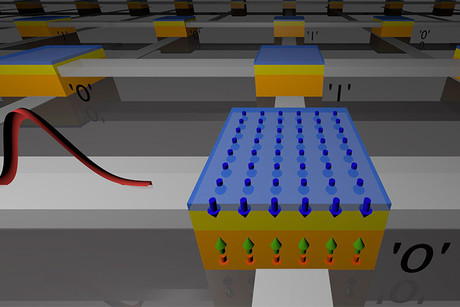Ultrafast magnetic reversal for high-performance, low-power memory

US researchers have developed an ultrafast method for electrically controlling magnetism in certain metals. Published in the journal Science Advances, their breakthrough could lead to increased performance and more energy-efficient computer memory and processing technologies.
Computers use different kinds of memory technologies to store data. Long-term memory, typically a hard disk or flash drive, needs to be dense in order to store as much data as possible. But the central processing unit (CPU) — the hardware that enables computers to compute — requires its own memory for short-term storage of information while operations are executed. Random-access memory (RAM) is one example of such short-term memory.
Reading and writing data to RAM needs to be extremely fast in order to keep up with the CPU’s calculations. Most current RAM technologies are based on charge (electron) retention, and can be written at rates of billions of bits per second or nanosecond. The downside of these charge-based technologies is that they are volatile, requiring constant power or else they will lose the data.
In recent years, magnetic alternatives to RAM, known as magnetoresistive random-access memory (MRAM), have reached the market. The advantage of magnets is that they retain information even when memory and CPU are powered off, allowing for energy savings. But that efficiency comes at the expense of speed — a major challenge for MRAM has been to speed up the writing of a single bit of information to less than 10 nanoseconds.
“The development of a non-volatile memory that is as fast as charge-based random-access memories could dramatically improve performance and energy efficiency of computing devices,” said Jeffrey Bokor, a professor at the University of California, Berkeley, who led the recent research. “That motivated us to look for new ways to control magnetism in materials at much higher speeds than in today’s MRAM.”
“Inspired by recent experiments in the Netherlands on ultrafast magnetic switching using short laser pulses, we built special circuits to study how magnetic metals respond to electrical pulses as short as a few trillionths of a second,” added study co-author Yang Yang, who earned his PhD at UC Berkeley. “We found that in a magnetic alloy made up of gadolinium and iron, these fast electrical pulses can switch the direction of the magnetism in less than 10 picoseconds. That is orders of magnitude faster than any other MRAM technology.”
“The electrical pulse temporarily increases the energy of the iron atom’s electrons,” continued Richard Wilson, currently an assistant professor at the University of California, Riverside. “This increase in energy causes the magnetism in the iron and gadolinium atoms to exert torque on one another, and eventually leads to a reorientation of the metal’s magnetic poles. It’s a completely new way of using electrical currents to control magnets.”
After their initial demonstration of electrical writing in the special gadolinium-iron alloy, the research team sought ways to expand their method to a broader class of magnetic materials. Addressing that challenge was the subject of a second study, published in Applied Physics Letters.
“We found that when we stack a single-element magnetic metal such as cobalt on top of the gadolinium-iron alloy, the interaction between the two layers allows us to manipulate the magnetism of the cobalt on unprecedented timescales as well,” said study co-author Jon Gorchon, a postdoctoral researcher at UC Berkeley.
“Together, these two discoveries provide a route toward ultrafast magnetic memories that enable a new generation of high-performance, low-power computing processors with high-speed, non-volatile memories right on chip,” concluded Bokor.
Organic transistor 'limitation' improves stability
Researchers have shown that a longstanding organic transistor design limitation actually improves...
OLED circular polarisation is now electrically switchable
Researchers have discovered a way to control left- or right-handed polarised light via charge...
Nanoscale pixels to advance augmented reality eyewear
Physicists have developed extremely small pixels that can be used in compact AR glasses, using...





